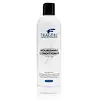What's inside
What's inside
 Key Ingredients
Key Ingredients

 Benefits
Benefits

 Concerns
Concerns

 Ingredients Side-by-side
Ingredients Side-by-side

Water
Skin ConditioningCoco-Glucoside
CleansingCetearyl Alcohol
EmollientBehentrimonium Chloride
PreservativeCetyl Esters
EmollientInulin
Skin ConditioningLactic Acid
BufferingAlpha-Glucan Oligosaccharide
CleansingGlycerin
HumectantTrichilia Emetica Seed Butter
EmollientOleic/Linoleic/Linolenic Polyglycerides
EmollientSaccharomyces/Rice Ferment Filtrate
Skin ConditioningGlyceryl Stearate
EmollientTocopherol
AntioxidantMyristyl Alcohol
EmollientArginine
MaskingParfum
MaskingLauryl Alcohol
EmollientSclerotium Gum
Emulsion StabilisingGuar Hydroxypropyltrimonium Chloride
Skin ConditioningSodium Hydroxide
BufferingButylene Glycol
Humectant1,2-Hexanediol
Skin ConditioningSodium Benzoate
MaskingLimonene
PerfumingWater, Coco-Glucoside, Cetearyl Alcohol, Behentrimonium Chloride, Cetyl Esters, Inulin, Lactic Acid, Alpha-Glucan Oligosaccharide, Glycerin, Trichilia Emetica Seed Butter, Oleic/Linoleic/Linolenic Polyglycerides, Saccharomyces/Rice Ferment Filtrate, Glyceryl Stearate, Tocopherol, Myristyl Alcohol, Arginine, Parfum, Lauryl Alcohol, Sclerotium Gum, Guar Hydroxypropyltrimonium Chloride, Sodium Hydroxide, Butylene Glycol, 1,2-Hexanediol, Sodium Benzoate, Limonene
Ingredients Explained
These ingredients are found in both products.
Ingredients higher up in an ingredient list are typically present in a larger amount.
Cetearyl alcohol is a mixture of two fatty alcohols: cetyl alcohol and stearyl alcohol. It is mainly used as an emulsifier. Emulsifiers help prevent the separation of oils and products. Due to its composition, it can also be used to thicken a product or help create foam.
Cetearyl alcohol is an emollient. Emollients help soothe and hydrate the skin by trapping moisture.
Studies show Cetearyl alcohol is non-toxic and non-irritating. The FDA allows products labeled "alcohol-free" to have fatty alcohols.
This ingredient is usually derived from plant oils such as palm, vegetable, or coconut oils. There is debate on whether this ingredient will cause acne.
Due to the fatty acid base, this ingredient may not be Malassezia folliculitis safe.
Learn more about Cetearyl AlcoholLactic Acid is another well-loved alpha hydroxy acid (AHA). It is gentler than glycolic acid but still highly effective.
Its main role is to exfoliate the surface of the skin by loosening the “glue” that holds dead skin cells together. Shedding those old cells leads to smoother, softer, and more even-toned skin.
Because lactic acid molecules are larger than glycolic acid, they don’t penetrate as deeply. This means they’re less likely to sting or irritate, making it a great choice for beginners or those with sensitive skin.
Like glycolic acid, it can:
Lactic acid also acts as a humectant (like hyaluronic acid). It can draw water into the skin to improve hydration and also plays a role in the skin's natural moisturizing factor (NMF) in the form of sodium lactate.
Studies show it can boost ceramide production to strengthen the skin barrier and even help balance the skin’s microbiome.
To get results, choose products with a pH between 3-4.
Lower strengths (5-12%) focus on surface exfoliation; higher strengths (12% and up) can reach deeper in the dermis (deeper, supportive layer) to improve skin texture and firmness over time.
Though it was originally derived from milk, most modern lactic acid used in skincare is vegan. It is made through non-dairy fermentation to create a bio-identical and stable form suitable for all formulations.
When lactic acid shows up near the end of an ingredient list, it usually means the brand added just a tiny amount to adjust the product’s pH.
Legend has it that Cleopatra used to bathe in sour milk to help reduce wrinkles.
Lactic acid is truly a gentle multitasker: it exfoliates, hydrates, strengthens, and brightens. It's a great ingredient for giving your skin a smooth, glowing, and healthy look without the harshness of stronger acids.
Read more about some other popular AHA's here:
Learn more about Lactic AcidWater. It's the most common cosmetic ingredient of all. You'll usually see it at the top of ingredient lists, meaning that it makes up the largest part of the product.
So why is it so popular? Water most often acts as a solvent - this means that it helps dissolve other ingredients into the formulation.
You'll also recognize water as that liquid we all need to stay alive. If you see this, drink a glass of water. Stay hydrated!
Learn more about Water